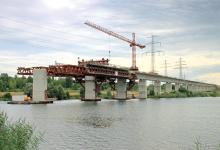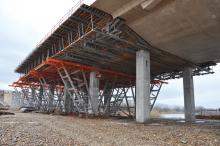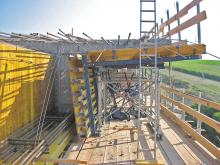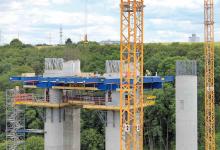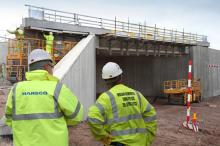The Holzmatttal Bridge for the A98 autobahn in southern Germany stretches 410m across the valley, and on this build the newly-developed Doka forming carriage TU is said to have demonstrated precisely how it drives progress with extremely short cycle times and speedy forming and stripping out operations. The underslung carriage also permits unobstructed access for site traffic.
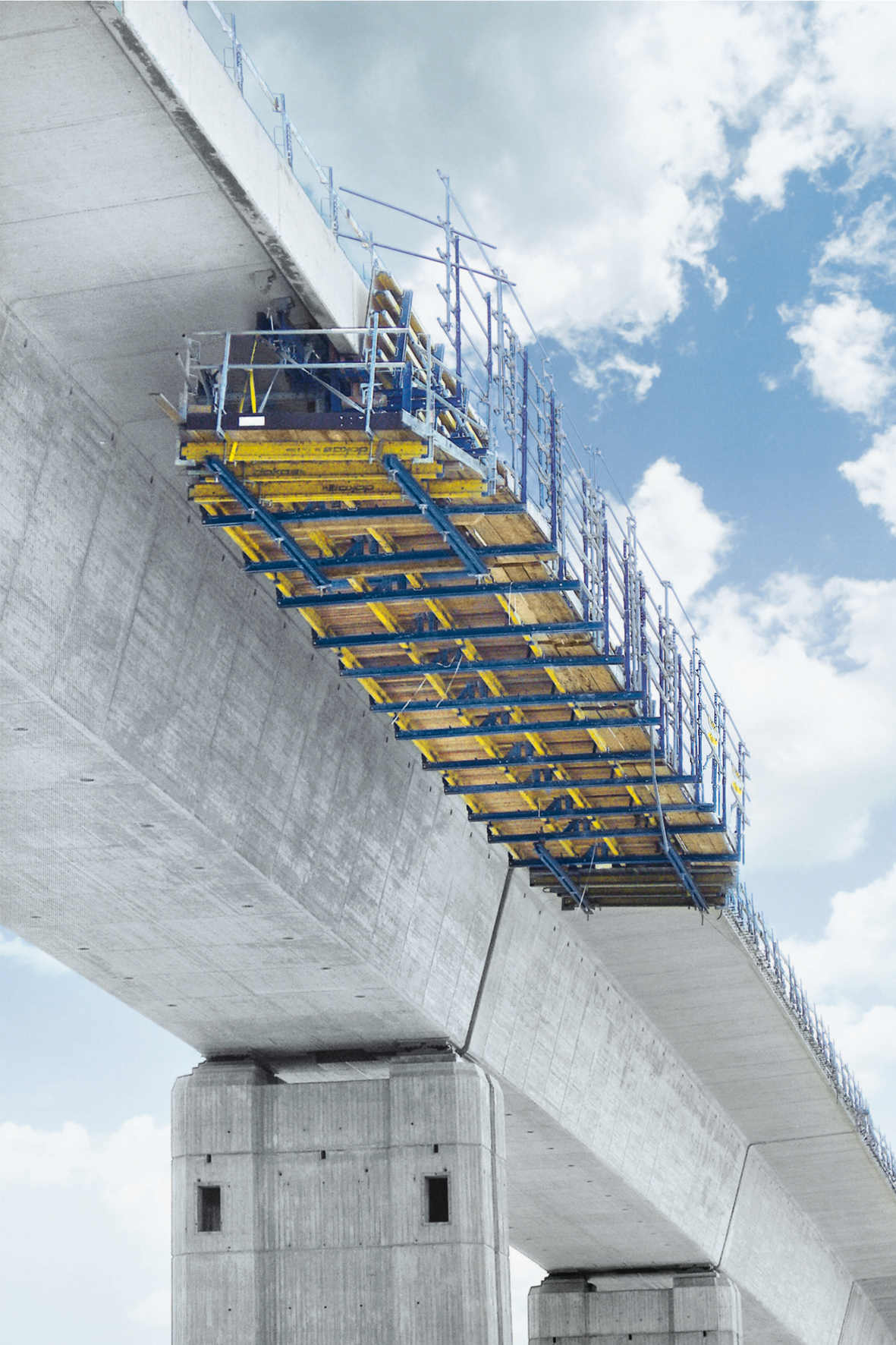
The underslung Doka forming carriage TU is said to offer fast cycle times and a high safety standard for the construction or repair of bridge edge beam caps
The Holzmatttal Bridge for the A98 autobahn in southern Germany stretches 410m across the valley, and on this build the newly-developed 203 Doka forming carriage TU is said to have demonstrated precisely how it drives progress with extremely short cycle times and speedy forming and stripping out operations. The underslung carriage also permits unobstructed access for site traffic.
The incremental launching method was used for the bridge, which was recently completed between the towns of Lörrach and Rheinfelden.
Its piers are up to 30m high and the prestressed concrete superstructure was carried across in a total of 17 launch steps. The edge cap dimensions are 30cm wide and 55cm high and the centre cap is only slightly smaller.
The TU forming carriage, which was launched at Bauma 2010, was used for both.
"The TU is an underslung carriage and since it is designed specifically for forming edge caps and centre caps on bridge superstructures it contributes significantly to optimisation of the construction process," says Doka.
"The entire carriage is slung underneath the superstructure, so the various steps in the construction process are easily separated. Sealing work and the job of casting the bridge edge beam can be tackled simultaneously boosting, for example, efficiency at a key phase in construction.
"In much the same way, an underslung carriage makes placing the reinforcement and pouring the concrete far easier. This solution dispenses with the ballast sleds plus rails that a top-riding edge-beam forming carriage inevitably requires. When it comes to repairing bridge edge beam caps this is a crunch factor, because the work can proceed without significant disruption of traffic crossing the bridge." It took nine weeks to finish the edge cap with three steps concreted per week, and according to Doka the key to this speedy progress is the innovative suspension system that carries the underslung forming carriage TU.
"Installation and removal of the two-part hangers are speedy, safe operations undertaken from the leading and trailing platforms respectively." Each platform is 2.9m long and the integral adjuster mechanism is designed for maximum versatility, so the hanger adjusts easily in all three dimensions to compensate for the inevitable slight geometrical irregularities of the superstructure. The bogey unit of the TU has side-mounted guide rollers so it can track round curves without time-consuming stoppages for repositioning. An integral, self-latching gravity brake secures the forming carriage, preventing uncontrolled movement. Fully enclosed and preassembled working platforms round off the safety package and ensure maximum safety for the crew throughout every phase of the build.
The TU is "design-perfect for speed in the forming and stripping out processes," with a special pivot mechanism enabling simultaneous horizontal and vertical movement: forming up and stripping out are involve a minimum number of steps.
Like Doka's Top 50 beam formwork, the TU was preassembled by the Doka Ready-to-Use Service and taken to site ready-to-go. The forming carriage arrived broken down into six units each 4m long, and they were fitted together under the professional eye of an experienced Doka site foreman.
The incremental launching method was used for the bridge, which was recently completed between the towns of Lörrach and Rheinfelden.
Its piers are up to 30m high and the prestressed concrete superstructure was carried across in a total of 17 launch steps. The edge cap dimensions are 30cm wide and 55cm high and the centre cap is only slightly smaller.
The TU forming carriage, which was launched at Bauma 2010, was used for both.
"The TU is an underslung carriage and since it is designed specifically for forming edge caps and centre caps on bridge superstructures it contributes significantly to optimisation of the construction process," says Doka.
"The entire carriage is slung underneath the superstructure, so the various steps in the construction process are easily separated. Sealing work and the job of casting the bridge edge beam can be tackled simultaneously boosting, for example, efficiency at a key phase in construction.
"In much the same way, an underslung carriage makes placing the reinforcement and pouring the concrete far easier. This solution dispenses with the ballast sleds plus rails that a top-riding edge-beam forming carriage inevitably requires. When it comes to repairing bridge edge beam caps this is a crunch factor, because the work can proceed without significant disruption of traffic crossing the bridge." It took nine weeks to finish the edge cap with three steps concreted per week, and according to Doka the key to this speedy progress is the innovative suspension system that carries the underslung forming carriage TU.
"Installation and removal of the two-part hangers are speedy, safe operations undertaken from the leading and trailing platforms respectively." Each platform is 2.9m long and the integral adjuster mechanism is designed for maximum versatility, so the hanger adjusts easily in all three dimensions to compensate for the inevitable slight geometrical irregularities of the superstructure. The bogey unit of the TU has side-mounted guide rollers so it can track round curves without time-consuming stoppages for repositioning. An integral, self-latching gravity brake secures the forming carriage, preventing uncontrolled movement. Fully enclosed and preassembled working platforms round off the safety package and ensure maximum safety for the crew throughout every phase of the build.
The TU is "design-perfect for speed in the forming and stripping out processes," with a special pivot mechanism enabling simultaneous horizontal and vertical movement: forming up and stripping out are involve a minimum number of steps.
Like Doka's Top 50 beam formwork, the TU was preassembled by the Doka Ready-to-Use Service and taken to site ready-to-go. The forming carriage arrived broken down into six units each 4m long, and they were fitted together under the professional eye of an experienced Doka site foreman.

